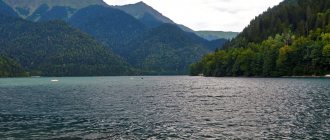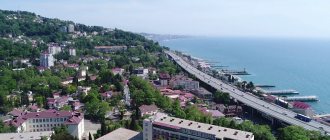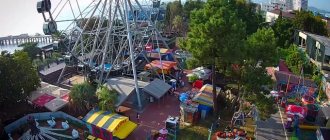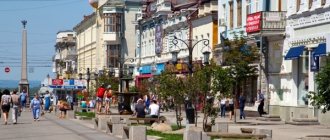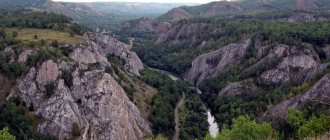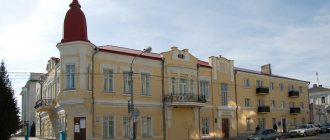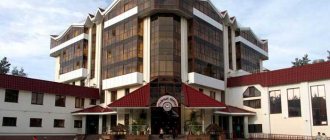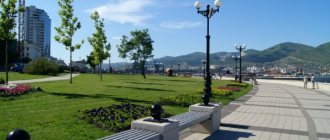A little history of the city
Thanks to its favorable geographical location, the Black Sea bay, where the city of Sevastopol is located, has long attracted sailors from different parts of Europe and Asia. The first settlers began to build here in ancient times, in the 5th century. BC e.
The city later became part of the Roman Empire, but was badly damaged by the invasion of the Goths and Huns during the Great Migration. Then the territory came under the rule of Byzantium and even the Khazar Khaganate.
In 988, the city was taken by the army of the Kyiv prince, known under the nickname Vladimir the Red Sun. The city at that time was called Korsun. According to legend, it was here that the prince was the first in Rus' to receive the rite of baptism, therefore 988 is considered the date of the Baptism of Rus'.
In later historical periods, the Genoese fortress of Chembalo and the fortified area of Kalamita were founded on the site of present-day Sevastopol. From these buildings, only the remains of the fortress towers have survived to this day.
The aggressive ambitions of the sultans of the Ottoman Empire did not leave the Crimean peninsula aside. For three centuries the city was part of the Turkish province, until as a result of the Russian-Turkish war at the end of the 18th century. The Crimean Khanate was not liquidated. From that time on, the history of Sevastopol began as a city of military glory in Russia. The first stone buildings appeared in the city, and fortifications were erected on the shores of the bay.
1853-1856 known as the time of the siege of Sevastopol by the troops of England, France and Turkey, during which the defenders of the city showed unparalleled heroism and fortitude. During the Great Patriotic War, Sevastopol again became the scene of bloody battles and was partially destroyed.
Sevastopol Aquarium
Website: sevaquarium.ru Address: Sevastopol, Nakhimov Avenue, 2.
The building of the Institute of Biology of the South Seas was built in 1898. During the war it was destroyed and subsequently restored. Nowadays the Sevastopol Aquarium Museum operates here, which is considered the first aquarium to appear on the territory of modern Russia.
Founded in the 19th century, it contains five modern halls. The exposition of the first hall demonstrates the inhabitants of the World Ocean. The following ones present the inhabitants of the Black Sea, freshwater animals from five continents, reptiles and aquatic organisms.
Historical landmarks
Beautiful places in Sevastopol often bear the imprint of historical events that they witnessed.
Chersonese Tauride
3 km from the city center there are the ruins of an ancient settlement known as Chersonesos. This agglomeration was a Greek colony 2500 years ago. Chersonesus was an example of high ancient culture, but was destroyed by wild tribes of nomads. The cultural life of the Greek colonists can be judged from the ruins. Tourists can see the ruins of temples and an amphitheater for theatrical performances that could accommodate up to 2,000 spectators.
Household items and works of applied art have survived to this day, giving an idea of the life of Greek settlers on the Crimean coast. The marble columns, which have stood for thousands of years and survived the invasion of vandals, amaze the imagination and are a good backdrop for photography and video shooting.
Chersonesos bell
On the territory of the Chersonese Museum-Reserve you can see a monument in the form of a giant bell weighing several tons. This monument has an interesting history. It was dedicated to the victory of Russian weapons and was cast from captured Turkish guns. After the capture of part of Sevastopol by Anglo-French troops in the middle of the 19th century. The bell was taken to Europe, where it ended up in the Cathedral of Notre Dame de Paris. Before the First World War, the French government returned the valuable cargo to Russia.
Beautiful places in Sevastopol - Chersonesos bell.
The bell was placed on the cape and used as a sound beacon. In thick fog, the sounds of the bell allowed the ships not to go astray and find the entrance to Sevastopol Bay.
Inkerman Monastery
Rock temples, carved into the rock, are one of the oldest architectural monuments found in Crimea. The beginning of the history of the monastery goes back centuries.
Historians of Orthodoxy associate this holy place with the birth of Christianity in Rus'.
Malakhov Kurgan
A low hill located on the Ship side of the city gave a strategic advantage in the battles to capture the city. This area is abundantly watered with the blood of the defenders of the Fatherland, who showed miracles of heroism during the battles in the 19th century. and during the Great Patriotic War. From the top of the hill there is a panoramic view of the bay, and on its slopes there is a magnificent park.
During your visit, you can see examples of artillery pieces used to defend the city.
Count's pier
In the 18th century Russia established its military presence on the Crimean shores, starting with the construction of a fortified fort and a pier for warships. A hundred years later, a spectacular building with snow-white rotundas, decorated with statues in the ancient style and marked with memorial plaques in honor of Russian emperors, appeared on the site of nondescript warehouses.
Today, the Count's Marina is considered one of the main city attractions and a place of worship for the military glory of the Black Sea Fleet.
Chersonesos lighthouse
A well-preserved lighthouse stands on a cape in the western part of Sevastopol. The building is more than 2 centuries old. The place is memorable because it was here that the last bloody battles took place during the siege of the city by Nazi troops.
According to legend, the lighthouse is under the patronage of St. Nicholas the Wonderworker, who helped the defenders of Sevastopol in difficult times.
St. George's Monastery
Historians find it difficult to determine the dating of the foundation of the monastery. There is a legend that the holy monastery was founded by sailors who escaped from a shipwreck. From the walls of the shrine from Cape Fiolent a picturesque view of the sea opens. Russian tsars and classics of Russian literature (Pushkin, Griboyedov, Chekhov, Bunin) honored the place with their stay.
The great painter Aivazovsky depicted the structure of the monastery in one of his paintings.
Military History Museum in Balaklava
During the Soviet era, the underground submarine base was a secret facility of state importance. Here the giant submarines underwent maintenance and were equipped with nuclear warheads. Today the complex, located inside Mount Tavros at a depth of 120 m, is open to the public.
The atmosphere inside the museum matches the aesthetics of spy novels: armored doors, a mysterious corridor system and an underground cove with dark water.
Panorama of the defense of Sevastopol
The large-scale artistic canvas depicts the feat of the city’s defenders during the years when Sevastopol was besieged by the Anglo-French squadron.
The work measures 14 m x 115 m and leaves an unforgettable impression thanks to the realistic depiction of the details of the battle of past times.
Monument to the Scuttled Ships
The obelisk in the form of a column is dedicated to the ships that were sunk at the entrance to Sevastopol Bay and blocked access to internal waters for the enemy squadron during the Crimean War. The monument is fixed on an artificial foundation and rises 17 m above the waters of the bay.
This reference table will help summarize information on the most interesting sights of Sevastopol:
| Sight | Visiting schedule | Cost of visit (RUB) | Contact information and address |
| Ruins of Chersonesos | From 9.00 to 17.00 seven days a week | up to 300 | Address: Sevastopol, st. Ancient, 1 Transport stop "Tavrichesky Chersonesos" |
| Defense panorama | From 10.00 to 18.00 seven days a week | up to 300 | Address: Istoricheskiy Boulevard, 1 Transport stop “Ushakov Square” |
| Inkerman Monastery | From 8.00 to 18.00, daily | Voluntary donations accepted | Address: Simferopol highway, 10 Transport stop "Hospital" |
| Balaklava Submarine Museum | From 09.00 to 16.00, except Monday and Tuesday | Up to 300 | Address: Balaklava district, Tavricheskaya embankment, 22 Transport stop: “Obolon” |
| Malakhov Kurgan | Around the clock | For free | Address: st. Heroes of Sevastopol Transport stop "Malakhov Kurgan" |
| Count's pier | Around the clock | For free | Address: Nakhimov Square, 4 Transport stop “Nakhimov Square” |
Memorial to the heroic defense of Sevastopol 1941–1942.
Address: Sevastopol, Nakhimov Square.
Opposite the monument to Admiral Nakhimov there is a memorial to the heroic defense of Sevastopol in 1941–1942. A massive concrete bas-relief depicting a warrior repelling the enemy’s onslaught was built in 1967, sculptor V.V. Yakovlev, architect I.E. Fialko. Three bayonets symbolize three assaults on Sevastopol by Nazi troops: in November, December 1941 and June 1942.
The granite plaques contain the names of military formations, units, ships that defended the city and the names of 54 heroes of the Soviet Union who were awarded this title for the defense of Sevastopol. Here the Eternal Flame burns and there is the Alley of Hero Cities of 13 steles of cities of the USSR and the Brest Fortress.
Gardens and parks
Beautiful places in Sevastopol include many works of landscape architecture, many of which are perfect for families with children:
- The park with the fabulous name “Lukomorye” has existed since the times of the USSR. Children's attractions, a mirror labyrinth, a zoological corner and a large number of wooden sculptures of characters from Pushkin's fairy tales, to which the park owes its name.
- Komsomolsky Park, located near the Southern Bay, is equipped with a fountain, attractions for children, and sports grounds. You can ride a horse or pony.
- The park, named after the famous Russian poetess Akhmatova, is very small and romantic. Nearby, in Pesochnaya Bay there is a beach with small pebbles. All visitors note the cleanliness, comfort and beautiful view of the sea.
- Victory Park is a modern, landscaped and spacious area with flower beds and luminous fountains of various configurations. There are paths for cycling, although many holidaymakers prefer the more modern skateboards and hydro scooters. Squirrels have settled in the park area and regularly demand treats from guests.
- In the summer, vacationers with children certainly go to the Zurbagan water park to have fun. Slides and attractions are designed for visitors of all ages.
"Girl-Russia"
Coordinates: 44.627647, 33.512616
Monument "Russia" / Fountravel.ru
The “Russia” monument appeared on the territory of the Konstantinovskaya battery during its reconstruction. The Russian Geographical Society worked especially hard on the latter, organizing its representative office in Sevastopol there. The monument symbolizes our country, which at first glance does not look aggressive. But the “girl” has in her hands not only a shield (self-defense), but also a sword (military power).
Reviews from visitors about the monument: “The sculpture is located at the entrance to the Konstantinovsky ravelin. Reflects Russia’s position as a Great Maritime Power!”, “With a gorgeous view behind you!”, “Good place. A decent monument."
Cultural sites and attractions
Beautiful places in Sevastopol are represented not only by historical monuments, but also by cultural heritage sites, as well as high examples of architectural art from different eras.
Among the most beloved objects by city guests are:
- Black Sea Fleet Theater building with a colonnade in an antique style fits perfectly into the architectural appearance of the ancient city, although it was built relatively recently (in 1954). According to the original idea, it was a house of culture and recreation for sailors. The result is a building that is more reminiscent of a palace for ceremonial receptions. A distinctive feature of the building is four clock dials mounted on a turret with a spire. Every hour the clock plays the melody of the anthem of the city of Sevastopol.
- The Tower of the Winds was conceived as an elegantly designed ventilation outlet for the Maritime Library. Despite its prosaic purpose, this design was loved by city residents. The miniature tower is made in the traditions of ancient Greek architecture, and along the perimeter is decorated with bas-reliefs with scenes from the myths of Hellas.
- The monument to Nakhimov was erected in memory of the exploits of the great naval commander, who covered the Russian fleet with glory in the battle with the Turks at Sinop, when the enemy suffered a crushing defeat. The sculptor’s original creation did not survive the destructive whirlwind of the first post-revolutionary years, but later the Soviet government remembered the great admiral and created a copy of the monument 13.5 m high.
- The tomb of the admirals of the Russian fleet is located in the Vladimir Cathedral, rightfully recognized as one of the most beautiful churches on the entire peninsula. The remains of naval admirals, who made up the glory of the Russian Navy, were buried here with honors.
- Intercession Cathedral, although it was built in 1905, its outlines resemble the works of Byzantine architects. The facade of the building is richly decorated with stucco, and the window openings are covered with elegant stone carvings.
- The art museum, housed in a historic merchant's mansion, houses an impressive art collection of more than ten thousand carefully selected pieces. There are departments for Russian artists and Western European art, as well as a rich collection of Meissen porcelain and bronze sculptures.
Monument to Admiral Nakhimov
Coordinates: 44.616600, 33.525312
The monument to Pavel Stepanovich Nakhimov was erected on Nakhimov Square of the same name on November 5, 1959. It replaced the old monument, which for ideological reasons was demolished in 1928. The figure of the great naval commander is depicted in full height. Her left hand lies on a naval broadsword, and her right hand holds a telescope and looks into the distance. Of particular value are the three high reliefs on the pedestal.
They, like the main monument of Sevastopol, are cast in bronze and demonstrate key facts of the admiral’s biography: “Battle of Sinop”, “On the 4th Bastion” and “Nakhimov’s Conversation with the Sailors” (source Wiki).
Behind the monument, if you stand facing the figure of P. S. Nakhimov, you can see the columns of the main entrance to Sevastopol - the Count's pier.
Places for walks and photo sessions
Beautiful places that are suitable for a leisurely walk and creating a collection of spectacular photographs can be found everywhere in Sevastopol.
Here are some productive ideas for walking:
- Historical Boulevard . This street with a long history has a large number of memorial objects. While walking along the boulevard, you can take time to see the sights and then have fun with a ride at the amusement park located nearby.
- Primorsky Boulevard - an embankment that has remained a favorite walking place for city residents and guests of Sevastopol for the last two centuries. The wide boulevard was built on the site of the Nikolskaya battery, which defended the city during the Anglo-French invasion in 1855, but was completely destroyed. After the retreat of the conquerors, a strong pavement was paved on the battlefield, flowers, shrubs and trees were planted. A little later, a theater was built on the embankment. In the evening, the boulevard was filled with the sound of a military orchestra. The embankment offers a picturesque view of the shores of the bay.
- In winter, ice-free bays in the vicinity of Sevastopol become a haven for migratory birds. To take a photo against the backdrop of snow-white flocks of swans, you need to take a ferry departing from Artillery Bay to the North Side and go down to the seashore. To attract the birds' attention, it is better to grab a treat. The favorite delicacy of the winged beauties is oatmeal and carrot pieces.
- An impressive panorama of Chersonesos opens from the opposite side of Quarantine Bay. Having visited the observation deck on the shore, tourists can take photos of sea views, ancient columns of Chersonesos and the current Orthodox church, built on the site where, according to legend, the Kiev prince Vladimir Krasno Solnyshko was baptized. The most unusual photographs are taken at sunset or twilight.
Malakhov Kurgan
Defensive tower of Malakhov Kurgan
Malakhov Kurgan is a memorial monument dedicated to the events of the Great Patriotic and Crimean Wars. At the moment, this is a hill on the Korabelnaya side right within the city, on which there are cannons, cast-iron memorial plaques and a branch of the museum “Heroic Defense and Liberation of Sevastopol”, as well as an eternal flame.
The green zone of Malakhov Kurgan deserves special attention: numerous plantings were made by representatives of embassy missions, leaders of the USSR and famous personalities. For example, the park contains trees planted by cosmonaut Yuri Gagarin and Vietnamese statesman Ho Chi Minh.
Natural attractions
Beautiful places in Sevastopol are often located close to nature. Many tourists prefer the charm of natural landscapes to the bustle of the city and the ceremonial gloss of monuments. The names of the beaches speak for themselves: Silver, Jasper, Marble, Bounty, Aquamarine.
We can recommend visiting first:
- Marble beach on the shore of Balaklava Bay. Here you can rent a kayak to admire the ruins of the Genoese fortress from the sea and sail inside the narrow lagoon, which in the old days served as a refuge for Black Sea pirates. Another option is to climb the hill and take panoramic shots of the surrounding area.
- Cape Aya is a picturesque fragment of the Black Sea coast, which is a pile of rocks overgrown with coniferous trees. Here you can walk along mountain paths, breathe in the relaxing aroma of pine needles, take a break from the scorching summer heat in the dense forest shade and get to beaches with clear water.
- Cape Fiolent is a true find for lovers of natural views and wild recreation. From the height of the steep rocky shore you can observe an impressive panorama of the water surface. Below the cliff there is a series of beaches with clear sapphire-colored water.
- One and a half kilometers from Cape Fiolent, a rock named in honor of St. George the Victorious rises in the sea, next to it is Jasper Beach, strewn with small multi-colored stones. A rock staircase from the St. George's Monastery, numbering 800 steps, descends to this beach.
- The aqueduct on the Chernaya River in its outline resembles the water supply systems of the ancient Romans, which is why it received its Latin name. In fact, this bridge for the water supply was built in the 19th century. on the initiative of Admiral Lazarev. The bridge is now abandoned. The quiet murmur of the river, shade from trees and green bushes give this place a special charm.
Tourists imagine beautiful places in different ways. For some, these are complete architectural ensembles, others see beauty in seascapes or stones that have witnessed historical events. In Sevastopol, each of the city’s guests will be able to find something that exactly matches his personal ideas about beauty.
Genoese fortress Cembalo
The fortress was built in 1343 near Balaklava, but now all that remains of it are the grandiose ruins of a temple, walls and a tower. Several centuries ago, there was a rapidly developing trading settlement here, founded by settlers from the Genoese Republic - hence the name.
Chembalo is one of the top most popular excursion destinations. And this is due not only to the desire to touch Crimean history, but also to the incredible view that opens from the top of Fortress Mountain to Balaklava, the non-standard local terrain and the Black Sea.
Balaklava Bay
Balaklava Bay has a reputation as the most picturesque bay of the Black Sea. It is an ornate sea bay, hidden along the perimeter by large rocks and juniper forests. Therefore, a miniature and quiet body of water cannot be seen from deep water.
People began to inhabit such a comfortable place 2.5 thousand years ago. Balaklava Bay has long been an excellent outpost for launching and repelling raids. Nowadays, yachting is developed in the bay, and many luxury hotels have been built. On the shore you can find cafeterias with an interesting variety of seafood dishes.
Intercession Cathedral in Sevastopol
There is a beautiful temple in Sevastopol - the Intercession Cathedral, built at the beginning of the 20th century. Its facade is a real delight: white stone walls, golden domes, graceful arched windows, skillful stucco, seven mosaic frontal icons - the 37-meter temple seems to be floating in the air. The interior, covered with paintings, is not much inferior to the façade.
Intercession Cathedral in Sevastopol
During the Soviet years, the cathedral building acted as a first-aid post, a hospital, a bomb shelter, an archive and even a sports school. It’s hard to believe now, but during this time the rich decoration of the cathedral was plundered. Credit should be given to the Ukrainian restorers who restored it to its former splendor in 1994.
Intercession Cathedral, located at st. Bolshaya Morskaya, 36, open daily from 7:30 to 19 hours. You can get to it by intracity transport, going to the “Pobeda Cinema” stop in the city center. When visiting an active cathedral, which is always filled with parishioners, you should wear modest clothing and respect the feelings of believers.
Naval Museum Mikhailovskaya Battery
Website: muzey-sevastopol.com
The museum building was built of limestone in the mid-19th century by order of Emperor Nicholas I as one of a dozen forts on the territory of Sevastopol. The battery was named in honor of Grand Duke Mikhail, the last son of the head of the Russian Empire. But now all military buildings from the times of the Russian Empire are famous sights of Sevastopol.
The former military building houses the Mikhailovskaya Battery Museum, which is part of the complex of the Military Historical Museum of Fortifications. The main exhibition is dedicated to the Crimean War. It is worth noting the structure of the museum: the exhibits are arranged in such a way that you can trace the history of the city from its foundation to the present.
Admiralty Vladimir Cathedral
On a hill in the center of Sevastopol is the main religious building of the sea city - the Admiralty Vladimir Cathedral. It was built in the second half of the 19th century. in neo-Byzantine style.
Admiralty Vladimir Cathedral in Sevastopol
In some sources on the Internet, including quite well-known ones, this cathedral is confused with the St. Vladimir Cathedral in Chersonesos.
The name of the cathedral was given by the tomb of the admirals of the Russian fleet, located inside. The names of four admirals - Nakhimov, Lazarev, Istomin and Kornilov - are carved on memorial slabs mounted in the facade.
A feature of the interior is the absence of icons. Instead, the walls are decorated with 33 marble slabs with the names of sailors - holders of the Order of St. George, who distinguished themselves during the defense of the city during the Crimean War. On special dates for the Russian fleet, special services are held here.
The address of the Admiralty Vladimir Cathedral is st. Suvorova, 3. The excursion can be booked in a small house next to the cathedral.
Art Museum named after M.P. Kroshitsky
Website: www.sevartmuseum.info
The Sevastopol Art Museum named after M.P. Kroshitsky was an attraction in itself. His collection was located in a historical building of the late 19th century on Nakhimov Avenue. But now the main building is under reconstruction, so the art collection can be found in the Moscow cinema.
In the M.P. Kroshitsky Museum you can see more than 8,000 works of art. Among them are paintings by Dutch and Flemish masters, works of modern art and works by 20th century artists from the USSR and nearby countries. The museum is based on works by Italians of the Renaissance, exhibits from museums in Moscow, St. Petersburg and Yalta.
Memorial complex "Sapun Mountain"
Sapun Mountain is an 8-kilometer spur of the Crimean Mountains, protecting the city from the southeast. The mountain became the scene of fierce battles four times. This happened twice during the Crimean War. During the Second World War, Sapun Mountain was defended for 250 days, and in May 1944 it was taken by a 9-day assault. The main exhibit of the complex, the diorama “Assault on Sapun Mountain,” is dedicated to this event.
Diorama “Storm of Sapun Mountain”
The diorama, measuring 25.5 by 5.5 m, was created based on the painting of the same name by Pyotr Maltsev. Its author led the group of military artists who worked on the diorama. Historical accuracy is observed in the smallest details. The diorama is located exactly at the site of the events depicted: this is easy to verify by going out onto the balcony after examining it.
The diorama represents the final moment of the assault. It also depicts the real heroes of the assault, some of whom managed to survive. The object component of the diorama largely consists of what was found at the battle site. Shots, explosions, and the noise of planes taking off make up the soundtrack, enhancing the impact on the viewer.
Most of the items found are on display on the first floor of the museum. Among the exhibits is a photograph of the legendary female sniper Lyudmila Pavlichenko, who took part in the battles for Sevastopol, and was called “Lady Death” by American journalists. She has 309 fascists killed, including 39 snipers.
In the center of the park laid out on the territory of the memorial complex is the obelisk of Glory with the Eternal Flame. The names of heroes are immortalized on memorial walls and plaques. Military equipment of those years is demonstrated in the open air.
The complex is open daily, except Tuesdays, from 10 a.m. to 6 p.m. A regular ticket costs 100 rubles, and an excursion ticket costs 250. It is convenient to visit the memorial after Malakhov Kurgan, continuing the trip by minibus 71 or 107.

